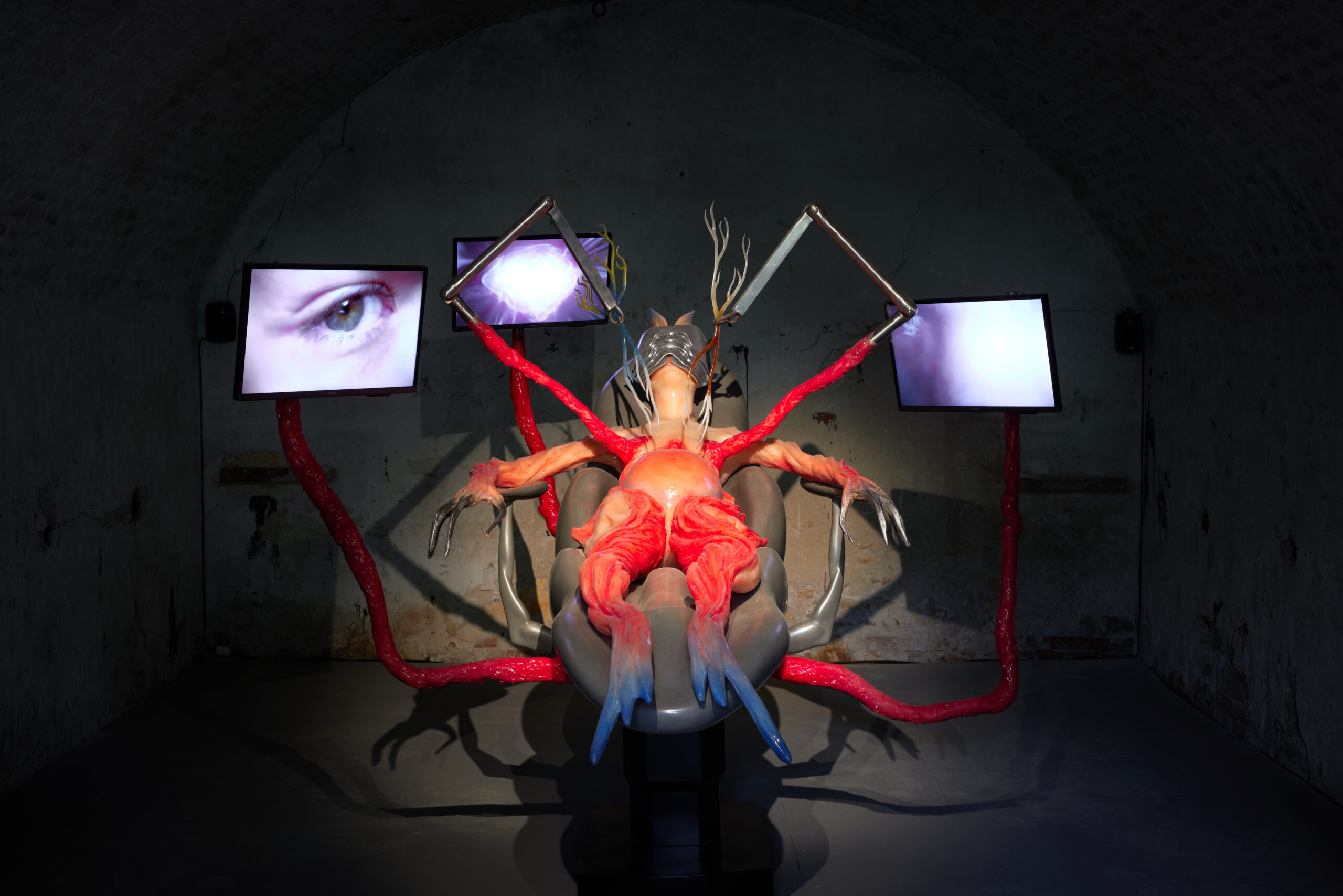Following a rigorous commission process, Agnes Questionmark, MFA Fine Arts ’25, is showcasing her work Cyber-Teratology Operation at the 60th International Art Exhibition of La Biennale di Venezia through November 24.
The Biennale includes more than 300 artists and collectives, whose work explores “the different, the foreigner, the journey, [and] integration.” These themes resonate with Questionmark’s body of work, which challenges societal norms and imagines expansive ways of being.
Questionmark’s installations and performances often revolve around hybrid creatures and bodies in flux, reflecting her commitment to questioning and proposing alternatives to biological limits. During her time at Pratt, she’s continued to hone her practice and ability to navigate the art world, while also finding supportive educators and a welcoming community.
In this Q&A, she discusses the intersections of life and art, her inspirations, and her journey as both an artist and a student.
What was the process of getting and then following through on your Venice Biennale commission like?
The selection process for the Venice Biennale under 35 was very demanding. The institute [Biennale College Arte] flew 12 young artists from around the world to Venice, on a tiny island (San Servolo) which once was an asylum. We lived on the island for two weeks. Every morning we took the ferry to get to the Biennale to attend curatorial meetings. We all had a meeting every day with a different curator, artist, or writer involved in the process of selection. Although every participant in the selective process was grateful for each other’s presence, the energy was still competitive.
As soon as I received the invitation and the production prize was dispensed, I started the production of the piece in my old studio in Rome with three technicians. Due to its large scale and complex form we had to divide it into three different formal techniques to smoothen its procedure. The installation will be exhibited at the Fondazione Candido Sperone Fendi, which acquired the piece for the opening of their new museum in Rome.
Cyber-Teratology Operation is a powerful meditation on bodily autonomy, transformation, and surveillance. What do you hope viewers take away from the piece?
In Cyber-Teratology Operation, I unveiled some of the most critical aspects of the current human condition: a creature whose face has been usurped and masked by the impositions of gender roles, with a decimated identity exposed only through its internal functions. This creature exists under the control of a medical system where it becomes its own self-surveilling medical apparatus.
In this entropic techno-organic composition, the viewer is compelled to confront their position in relation to it. While some may dismiss it as a far-fetched sci-fi allegory, it is, in fact, a reflection of the present. The real question is: where do we go from here? What steps must we take to survive amidst the inescapable subjugation to robotic doctors who ominously control and surveil our bodies? How do we reclaim our agency over transformation? And what are the limits of that transformation?
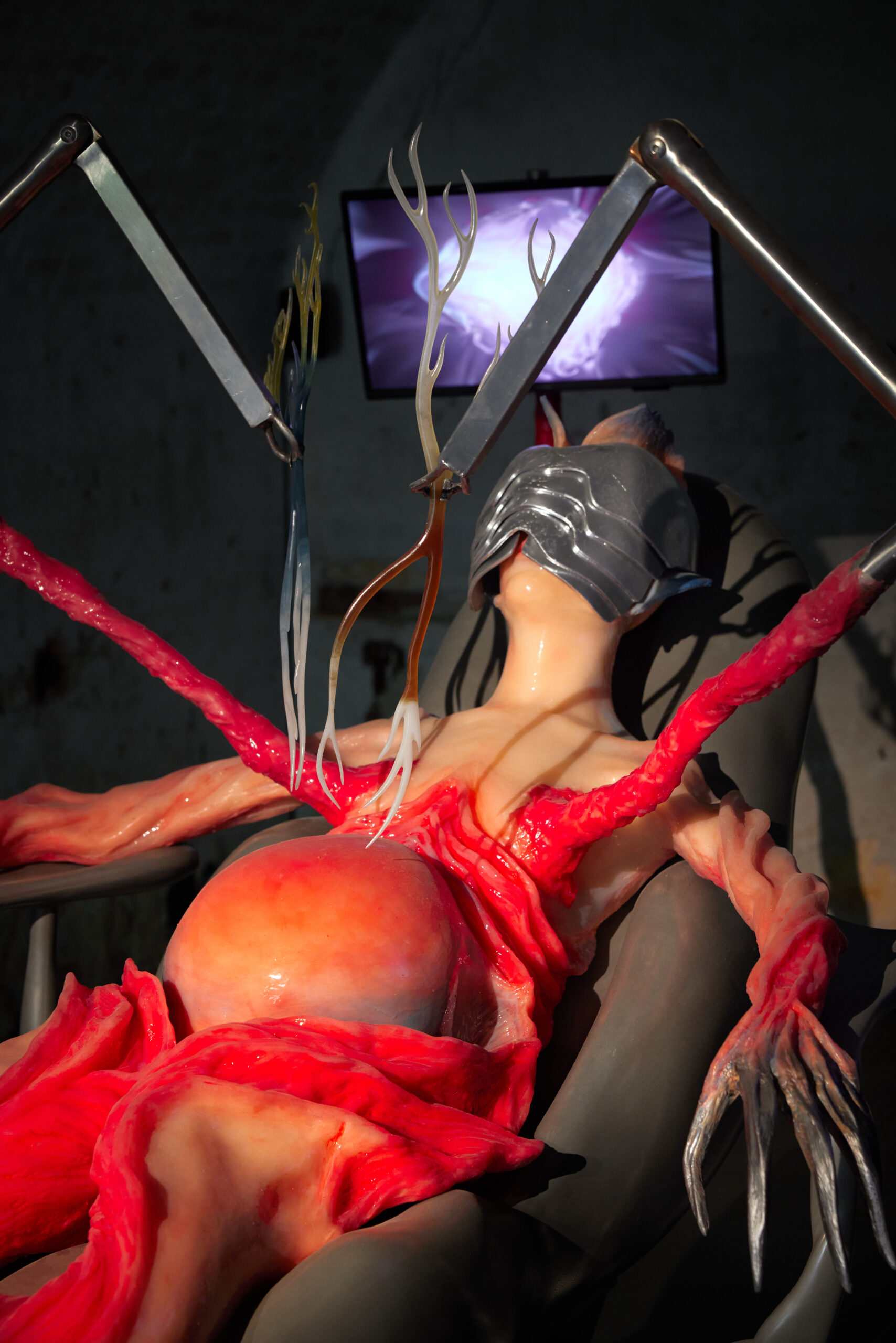
How has your time at Pratt — from the curriculum and your practice to spending time in Brooklyn — changed your approach to art?
Working in New York feels like you are not missing out on anything from the world’s art community. These are artists that come from all over the world, sharing their work and research to question your own, making you vulnerable and fragile, overstepping your limits and pushing you to constantly rethink and reinvent yourself. It is a permanent input and stimulation of new ideas and trajectories. The New York art scene is also very active and people are genuinely curious to meet you, so I always have people visiting my studio. I was very surprised to see so many people queuing up last year to see my first performance in the city.
In New York there is an overall excitement which creates a sort of safe space for your work to be exhibited. I feel the audience isn’t very critical or judgmental and it tries to grasp the best of it. Luckily, students and professors at Pratt have really stimulated my curiosity to understand the reasoning behind my work, the message I want to deliver and ultimately to push the boundaries of my performances, which doesn’t really happen often elsewhere.
You’ve spoken at length about how your life informs your work, that they’re ultimately a joint project. What would you tell other artists who are similarly interested in using their lived experience as subject matter?
Artists are storytellers, and by sharing their personal experiences, they have the power to dismantle the social norms that regulate our lives. It’s essential that we recognize and protect the responsibility that comes with our work—the potential strength of shared experience—and not underestimate the power of our words.
My words are my weapon, and my art is my fight against a system long confined and subjugated by the narratives that science and the medical establishment have imposed since their domination began. We must unpack and challenge these stories that limit our agency over our own bodies. At the same time, we must embrace and amplify the stories from the past that legitimize and empower our fluid identities, rewriting and sharing them until they become common knowledge.
As Edouard Glissant says, culture is the precaution to be taken towards those who attempt to steer it away from its chaos. It is knowledge in becoming, a force that we all share, impossible to be claimed individually.
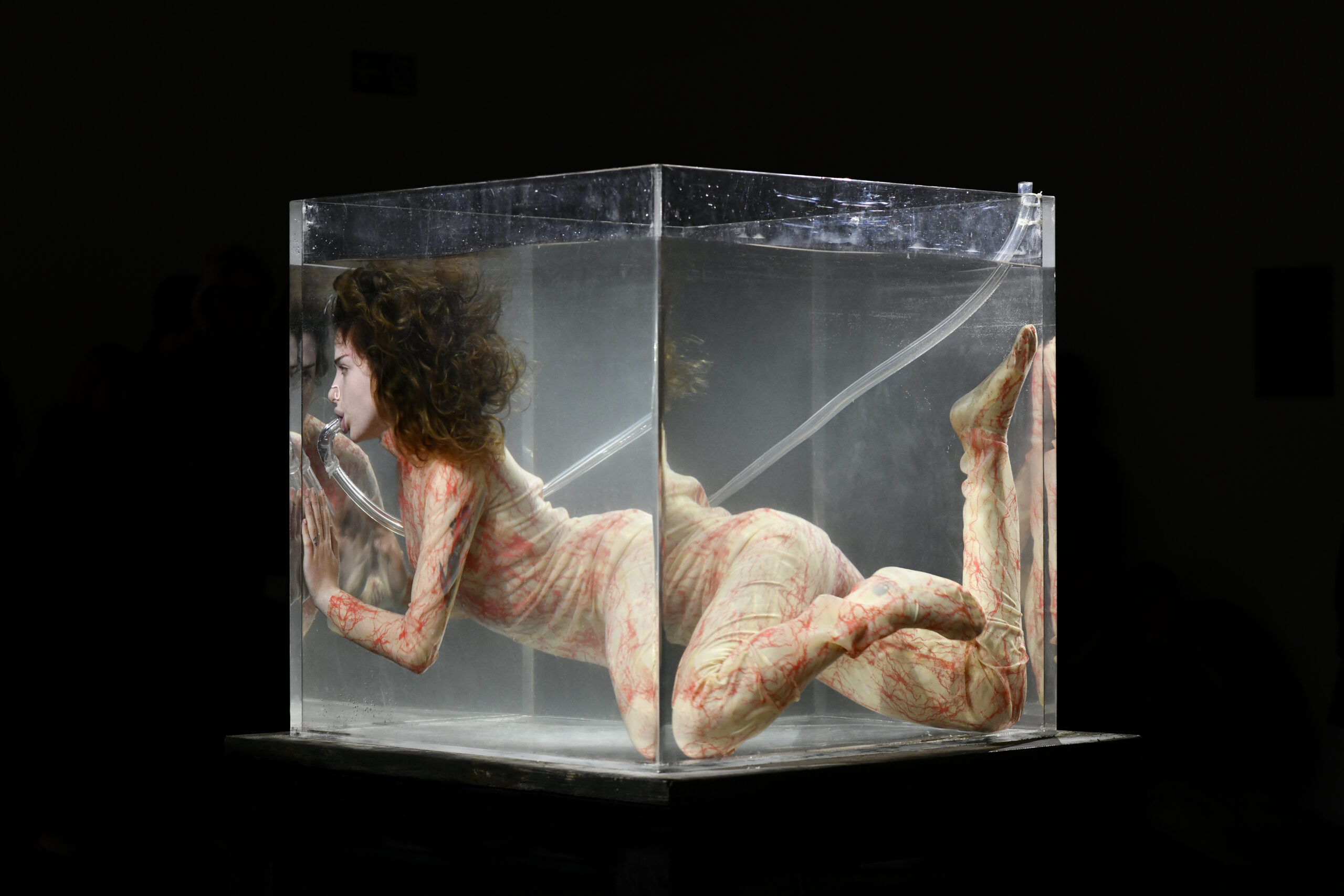
Embodiment comes up a lot in your work. What makes you want to explore it?
During my first performance at Camberwell College of Arts (London) in 2016, I felt an urgent need to present my body in search of its own self. For about three to four hours, I moved unfired clay boxes from one side of the gallery to the other, constructing a cubical pyramid that slowly melted and eventually collapsed. This was my way of expressing the frustration I felt in the search for Agnes, a fictional (but not too fictional) character I was desperately seeking, asking her questions, and begging for her response. At the time, Agnes was only an abstract thought—an invisible yet perceptible being I longed to embody. In those early performances, I could, if only for a brief moment, invoke and summon her, feel her, and perhaps become her. While it seemed obvious to others, it took me a few years to realize that I was Agnes. A transformation was necessary. A radical change had to happen. Without hesitation, I acted.
Since doctors hold the authority, knowledge, and tools to shape identities through their scrutinizing and often discriminatory medical gaze, I had no choice but to go to the hospital and submit to the pathologizing process of gender transition to assert and give birth to Agnes. Slowly, my body began to change, and I could finally see her. Yet, this shift in understanding my own body redefined its path in society: by becoming a patient, treated, manifested, and endured as such, I began to see the ominous role of the healthcare system in regulating social and political norms, shaping the trajectory of our “human” and “non-human” development, constantly surveilled and defined by technological advancement.
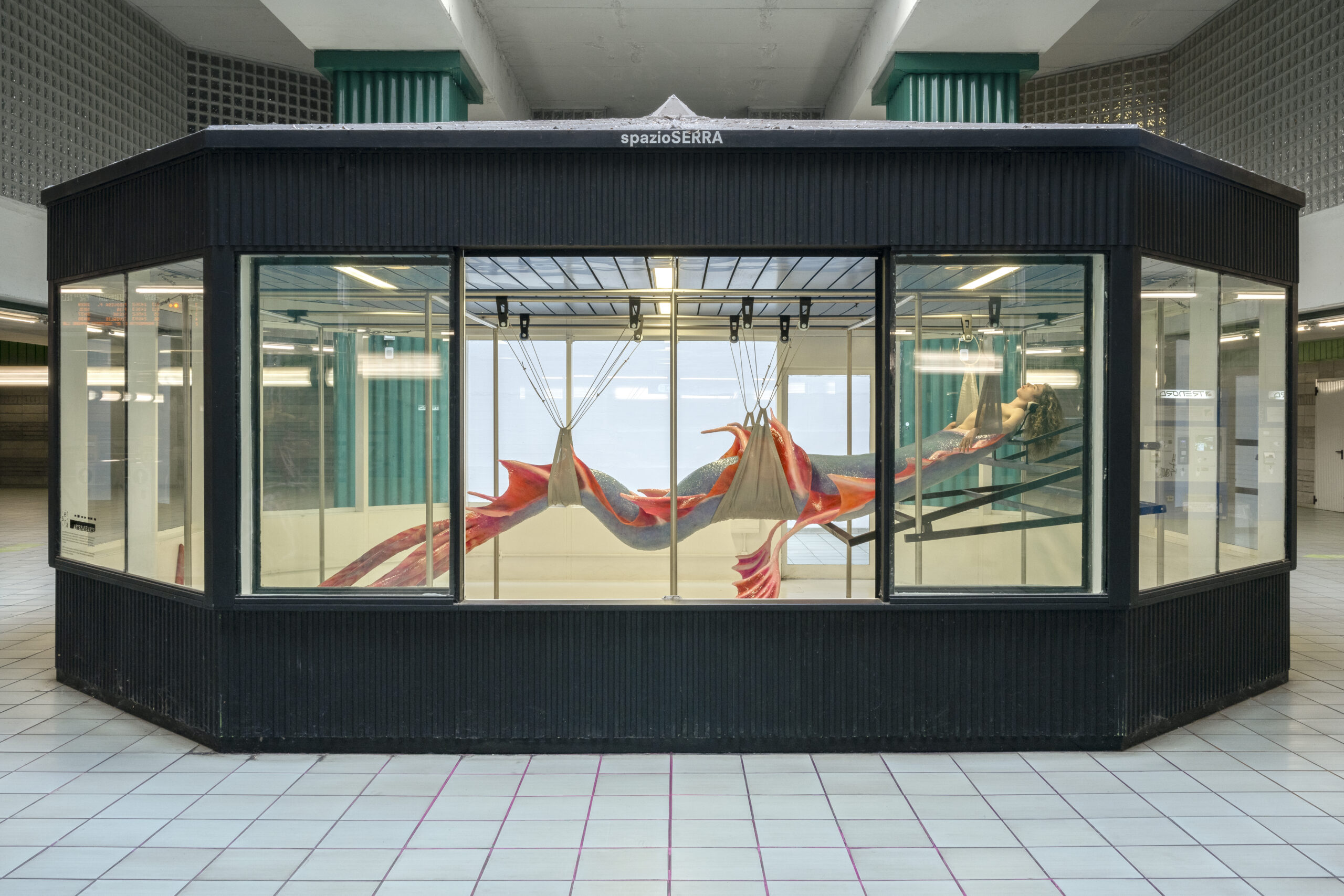
Agnes had always been the recipient of my deepest and most sinful questions, so I honored her surname with the unreadable symbol “?,” which quickly became a hindrance in bureaucratic systems that only accept legible words to address people. The symbol soon transformed into its own grammatical spelling—an allegory of the reification of an unaccepted being, unable to be pronounced. I became my own fictional persona, and my body became its representation. The word “Questionmark” is the embodiment of the question, and my body is the receptacle of its personhood. I am my own work—a question yet to be answered, inseparable from it.
Though I became the character I was searching for, the quest for the unknown persists in my work. The desire to transcend the limits of my biological body drives me to create hybrid installations where humans transform into undefined creatures, and organs take on their own independent life. As synthetic life forms invade my studio, I become the doctor of my own self, operating on my body to the rhythm of a robotic assisted surgery.
Your work often references the importance of the ocean and marine animals, in particular your underwater performances and your long durational piece TRANSGENESIS. What draws you to the aquatic world?
In TRANSGENESIS I performed for eight hours per day for 23 consecutive days in an unused swimming pool in North London. Embodying a giant octopus as vast as the pool itself, I became a symbol of the grotesque and the abject—what I was being pushed away from—while simultaneously being forced to obey the abnegation of a biological norm.
To become an octopus is a way of liberation and of freedom; a challenge to biological confinements and exploring the unknown resources of the unconscious, overshadowed by the quest of scientific rationality.
My interest in marine biology comes from my childhood. I grew up in my father’s boat in Italy, on the island of Ponza, where I would spend most of my summer underwater along with other marine creatures. Although the sea was my home it also represented a great fear of adventures that I was not able to overcome. Being in a boat isn’t always joyful, there’s plenty of dangers and obstacles to respond to. Performing underwater is for me a way to sublimate my fear of being submerged, of suffocating, of floating in absence of gravity and submitting to the dangers of water.
To become water, and to embrace its qualities, poses important questions during my research. Is there a way to become posthuman, to trespass the limit of a scientific structure while empowering the multiple transformative agencies that belong to nature? Is there a way to cross the limit of our body without falling into a discriminatory enhancement typical of transhumanists?
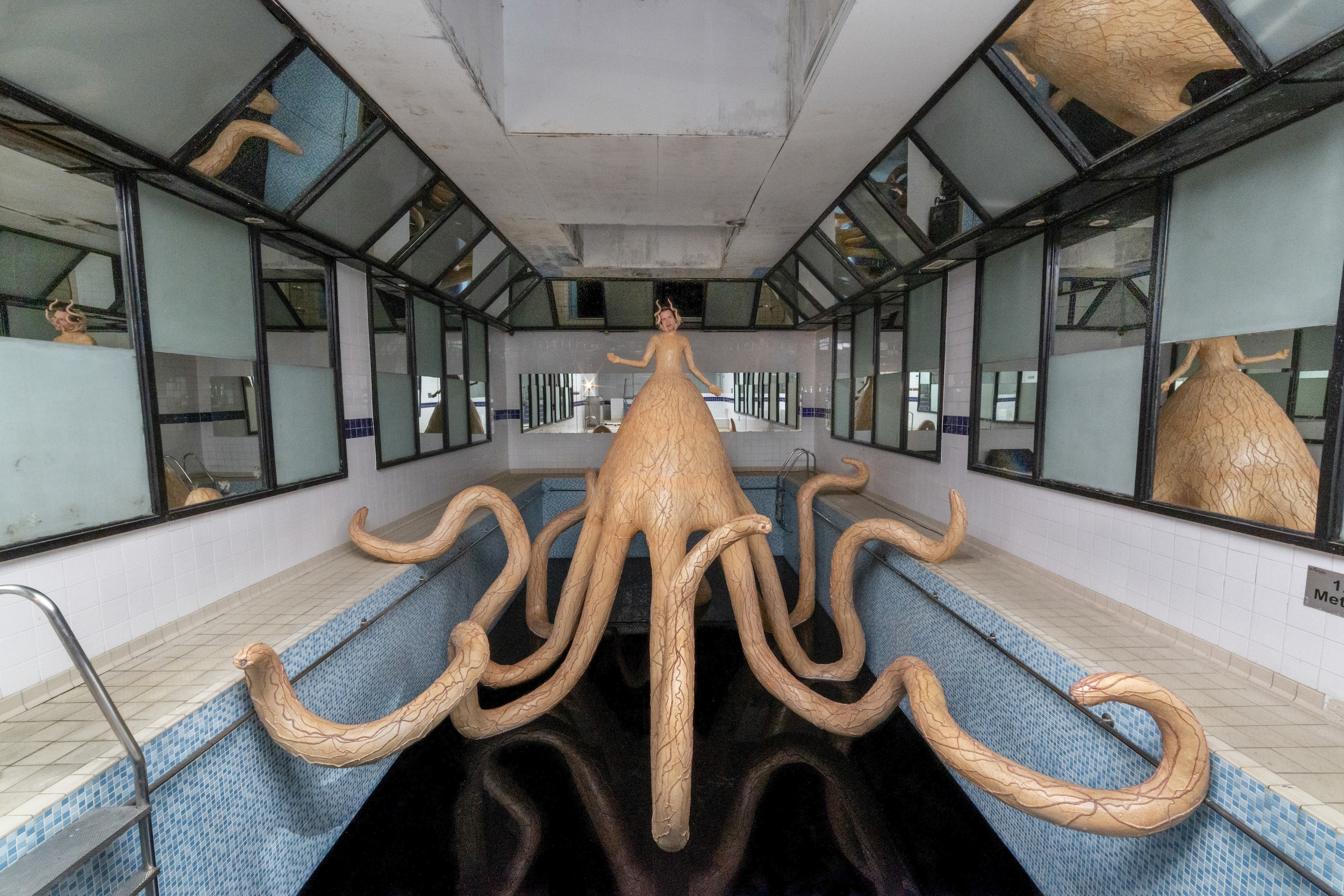
Can you talk about how your work is influenced by different exhibition spaces or any other kind of spaces?
The theater is the place where my whole body quivers, where torment unleashes its desire and takes form on the stage. Bodies cease to exist in their “natural” state and instead create images that, though fictional, are perceived as if they have always existed. Ubu Roy invented “Pataphysics,” where scientific laws collapse and the imagination reigns. A theatrical experience can provoke deep reflection on the most controversial social issues through the creation of absurd images composed of objects, bodies, and forms. With my work, I bring back the frames of the theater, allowing the audience inside the stage—like the early days of the surgical room, also called the “theater room” for its original configuration, where students observed operations from above as if attending a performance. But in my work, the roles are convoluted and displaced. The doctor-patient relationship, like that of actor-spectator, shifts, returning transformative agency to its originator.
To emphasize the clear parallels, or even the undeniable specularity, between the theater stage and the surgical room, I was invited by a German collector to witness a real eye surgery performed by a robot in a Berlin clinic. Participating as a researcher in medicine and robotic surgery, with the aim of legitimizing a posthuman discourse, I was both thrilled and moved by the entire process of “dehumanizing” both patient and doctor in the highly equipped surgical room. The only organic element visible in that exuberant technological interlock was the single eye, where a micro-operation was about to take place. The operation occurred inside the eye, with a micro-camera allowing both the surgeon and the other actors (myself included, as the sole spectator) to see.
This has been, without a doubt, the most inspiring experience I have ever participated in.
What’s next for you as you finish the program at Pratt and look ahead?
The Venice Biennale has opened many doors for me, as has my course at Pratt, which helped me develop a professional language—an essential tool for survival as an experimental artist, where constant explanation and expression of often unwelcomed or incomprehensible ideas is necessary. In Italy, I am experiencing a fair amount of success in institutional shows and curated exhibitions. Specifically, I am preparing for a new solo exhibition in Lucca, Tuscany, at the SPE – Spazio Performatico ed Espositivo, supported by the Dello Scompiglio Association and curated by Angel Moya Garcia.
